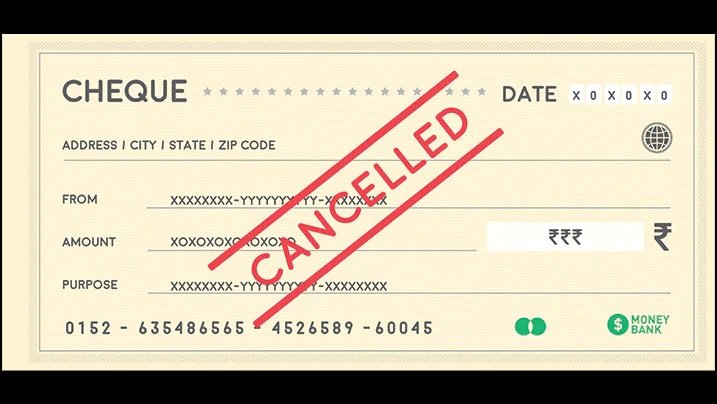A canceled cheque is often required for various financial purposes, such as opening a bank account, setting up ECS (Electronic Clearance System), or verifying bank details. While it’s a simple process, understanding the right way to cancel a cheque and knowing when a signature is required can save time and avoid errors. This guide (How to Cancel a Cheque) explains everything about canceling a cheque and whether a signature is necessary.
What Is a Cancelled Cheque?
A canceled cheque is a cheque that has been crossed with the word “CANCELLED” written across it. It ensures that the cheque cannot be used for any financial transactions. It serves as proof of your bank account details, such as the account number, account holder’s name, IFSC code, and MICR code.
Why Is a Cancelled Cheque Required?
Canceled cheques are often used for non-transactional purposes, including:
- Bank Account Verification: For opening savings or current accounts.
- Loan Applications: As proof of bank account for EMI deductions.
- ECS Setup: To authorize recurring payments like salary credits or utility bills.
- Insurance Policies: For processing insurance payouts or claims.
- KYC Procedures: To comply with Know Your Customer requirements.
Key Point: A canceled cheque only provides details of your bank account and cannot be used to withdraw money or make transactions.
How to Cancel a Cheque
Step-by-Step Process to Cancel a Cheque
- Choose an Unused Cheque:
Take a blank cheque from your checkbook. Ensure it is not already signed or filled in. - Write “CANCELLED” Across the Cheque:
Using a pen, write the word “CANCELLED” clearly across the cheque. Write in capital letters to ensure visibility. - Avoid Obstructing Key Information:
While writing “CANCELLED,” ensure the following details remain visible:- Account holder’s name
- Bank name and branch
- IFSC code
- MICR code
- Account number
- Do Not Sign the Cheque (Unless Required):
Generally, a signature is not required on a canceled cheque, as it’s only for verification purposes. However, certain institutions might ask for a signature for added authentication.
CCanceledCheque Signature: Is It Required?
Whether a signature is needed on a canceled cheque depends on the purpose for which it is required.
Situations Where a Signature May Be Required
- Loan Applications: Some lenders may require you to sign a canceled cheque to verify its authenticity.
- Insurance Claims: Insurance providers might request a signed cacanceledheque for processing payouts.
- ECS Mandates: In rare cases, banks may ask for a signed cancanceledeque for recurring payment setups.
Situations Where a Signature Is Not Required
- KYC Verification: For general KYC procedures, a signature is not mandatory.
- Bank Account Opening: Most banks accept unsigned canccanceledques for verifying account details.
- Salary Account Setup: Employers rarely demand a signature on cancecanceledues.
Key Tip: Always confirm with the requesting institution whether a signature is necessary to avoid errors.
How to Ensure the Security of a Cancelled Cheque
While providing a cancel canceled is generally safe, misuse is possible if the cheque falls into the wrong hands. Follow these tips to secure your cancel canceled:
- Write “CANCELLED” Clearly: Use a bold marker or pen to cross the cheque, making it unusable for transactions.
- Do Not Sign Unnecessarily: Avoid signing the cheque unless explicitly required.
- Provide It Only When Necessary: Hand over canceled only to trusted entities or verified institutions.
- Keep a Copy: Maintain a photocopy or digital copy of the canceled order for your records.
Common Mistakes to Avoid When Cancelling a Cheque
- Blocking Key Details: Ensure the account number, bank name, and IFSC code remain visible.
- Using a Used Cheque: Always use a blank, unused cheque to avoid confusion.
- Signing Unnecessarily: Do not sign the cheque unless specifically requested.
Alternatives to a Cancelled Cheque
In some cases, institutions might accept alternatives to a ccanceledcanceleduch as:
- Bank Passbook Copy: A photocopy of the first page showing account details.
- Account Statement: A recent bank statement with complete account details.
- Debit Card Copy: A front copy of the debit card showing your name and account number.
FAQs on Cancelling a Cheque
1. Can a Cancelled Cheque Be Used for Transactions?
No, a canceled cheque cannot be used for any transactions as it is marked “CANCELLED.”
2. What Happens if I Forget to Sign a Cancelled Cheque?
In most cases, it won’t be an issue since a signature is not mandatory unless specifically requested.
3. Can I Use a Photocopy of a Cancelled Cheque?
It depends on the institution. Some may accept a photocopy, while others require the original.
4. What Should I Do if I Lose a Cancelled Cheque?
Inform your bank immediately to prevent misuse and issue a fresh canceled cheque if needed.
Finally To Sum Up
Cancelling a cheque is a straightforward yet essential process for verifying your bank account details. Write “CANCELLED” clearly across the cheque and avoid signing it unless explicitly required. Understanding when and why a signature is necessary ensures you comply with institutional requirements without compromising security. Always handle cacanceledheques carefully and only provide them to trusted entities.
Key Takeaway: A cancanceledeque is a valuable tool for financial verification, but its security depends on how you handle it.

